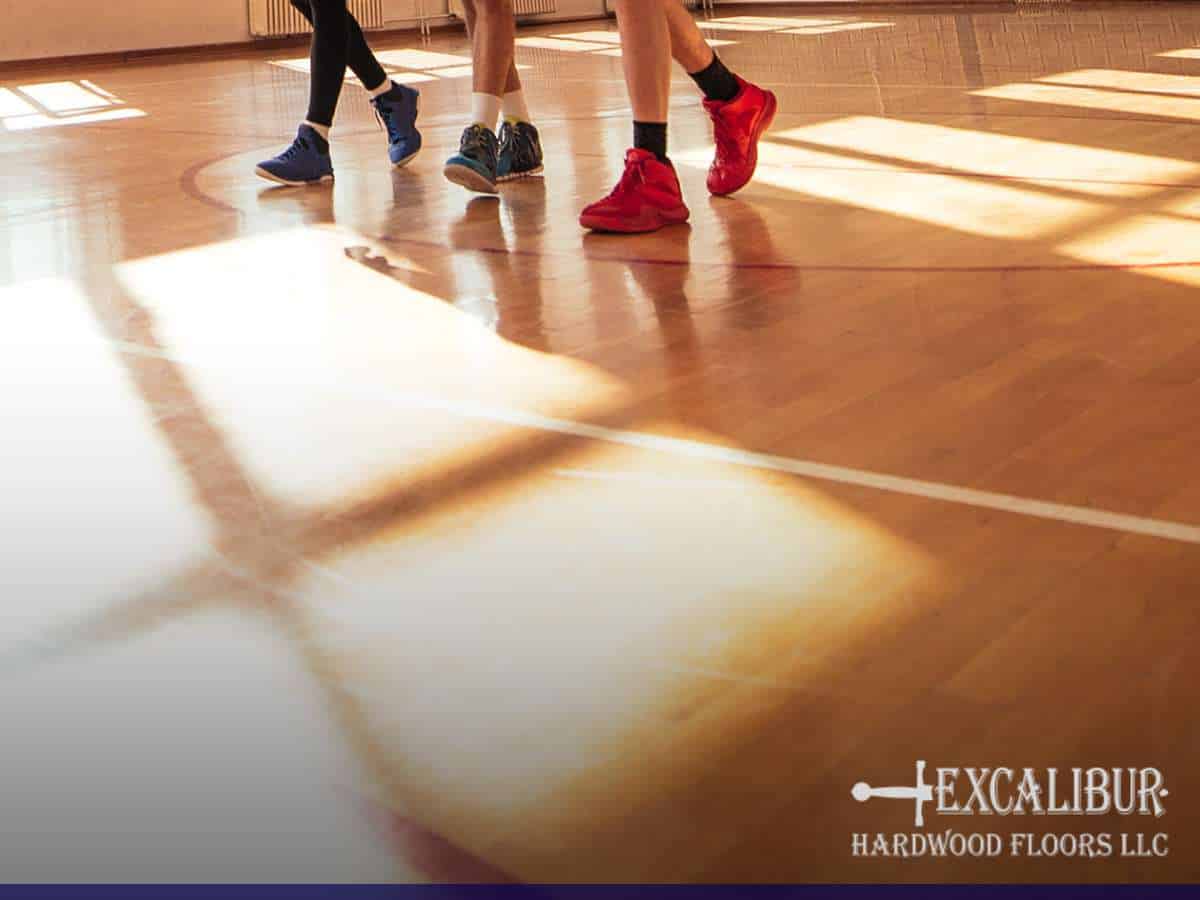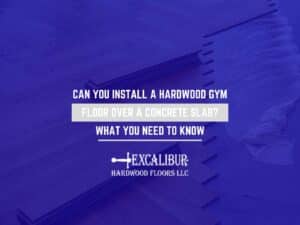Is Your Hardwood Floor On Concrete Failing? Look For These Signs
How To Prevent Damage & Extend The Life Of Your Sports Court Flooring
Think about top-tier gyms and sports facilities. The first thing that probably comes to mind is hardwood flooring, prized for its elegance, durability, and performance. But when installed directly over concrete, even the best floors can begin to fail without proper care.
If your facility’s hardwood floor on concrete is showing signs of trouble, you’re not alone. Understanding the early warning signs can help you prevent serious damage, avoid costly repairs, and maintain optimal safety and performance on your sports court.

The Hidden Challenge Of Concrete Substrates
Concrete is a strong and stable base, but it has one major drawback: moisture retention. Unlike other surfaces, concrete slabs can hold water for long periods if not given enough time to dry. If this moisture isn’t properly managed before hardwood installation, it can cause serious problems. For example, it can affect maple sports flooring durability and overall performance.
To prevent flooring failure, your contractor should thoroughly assess the slab before installation. This involves testing for:
- Dryness: The slab must be left to cure for at least 60 days after being poured. Installing hardwood too soon increases the risk of moisture-related damage.
- Flatness: An uneven slab will cause problems like dead spots, inconsistent ball bounce, and surface instability.
- Hardness: The slab should fall within a specific PSI range (typically 3,000–3,500) to support proper bonding without harboring excess moisture.
Skipping or rushing these steps can compromise even the best flooring materials and installations.
Subtle Signs That Indicate Trouble Ahead
While dramatic damage such as buckling or warping is easy to identify, there are more discreet clues that your hardwood floor is in trouble. Catching these early can mean the difference between a quick fix and a total replacement.
1. Persistent Condensation Or Moisture
If you’re noticing a sheen of water on the floor surface without an obvious source, this could signal a moisture problem beneath the hardwood. Condensation often builds up between the slab and floorboards when indoor humidity fluctuates significantly. These trapped vapors can slowly degrade your flooring, loosening boards and damaging finishes.
Using a thermo-hygrometer to monitor temperature and relative humidity in your facility can help you stay ahead of potential moisture-related issues.
2. Soft Spots Or Uneven Bounces
Have you noticed areas of your gym floor where the ball doesn’t bounce correctly, or where the surface feels spongy? These issues are rarely accidental and usually indicate problems with the installation process or unevenness in the concrete slab.
When a concrete slab isn’t perfectly level, it creates dead zones under the hardwood. These not only affect sports court surface performance but also create long-term structural weaknesses that can shorten the life of your floor.
3. Strange Or Musty Odors
One of the most overlooked warning signs of moisture problems is odor. When moisture accumulates beneath hardwood flooring, it creates the perfect breeding ground for mold and bacteria. Over time, this can lead to unpleasant, musty smells in your gym or sports facility.
If the smell is persistent, it’s worth investigating what lies beneath the surface before health hazards or irreversible damage sets in.
4. Visual Clues: Gaps, Cupping, Or Crowning
Visual changes are often the clearest signs of trouble. Cupping (edges of boards higher than the center), crowning (center of boards higher than the edges), or wide gaps between planks can all signal moisture damage, poor acclimation, or structural issues with the subfloor.
These symptoms typically develop gradually but worsen quickly once they appear. If you spot them early, sanding, refinishing, or localized repairs may still be an option.
Is The Problem Due To Poor Installation?
Even premium hardwood won’t perform well if installed incorrectly. Many flooring failures occur due to missed installation steps, improper adhesives, or failure to allow the wood to acclimate to the building’s climate. Without proper acclimation, the wood may expand or contract too much after installation.
This can cause cracks, creaking noises, and eventually lead to costly repairs or complete replacement. That’s why it’s vital to choose a contractor familiar with long-lasting gymnasium hardwood. They will ensure your floor meets all necessary performance and safety criteria for sports facilities.
Why a Subfloor Makes All The Difference
Installing hardwood directly over concrete might seem like a convenient or budget-friendly choice, but skipping a proper subfloor often results in costly problems down the road. A properly constructed subfloor offers several important advantages, such as:
- Shock absorption: Reduces strain on athletes’ joints and lowers the risk of injury.
- Performance enhancement: Supports better ball bounce, responsiveness, and overall hardwood floor impact resistance.
- Sound dampening: Minimizes noise during gameplay and improves acoustics in the facility.
- Moisture protection: Acts as a barrier between the hardwood and the concrete slab, helping prevent damage from trapped humidity or leaks.
- Extended durability: Helps preserve the integrity and lifespan of the flooring system under heavy daily use.
A well-selected subfloor system contributes significantly to both the athletic performance of the floor and its overall durability over time.
Long-Term Care & Maintenance Tips
Prevention is always better than cure. Regular maintenance routines not only keep your floor looking good but also help detect small issues before they escalate. Here’s what you can do:
Regular Visual & Physical Inspections
Make it a habit to walk through and inspect your gym floor regularly. Look for visible signs of wear such as scratches, gaps between boards, or slight warping. Pay attention to any unusual changes in how the surface feels underfoot or how it sounds—soft spots or hollow noises may point to hidden problems beneath the surface.
Keep Humidity Under Control
Humidity levels inside a facility can fluctuate with the seasons, and hardwood is highly sensitive to these changes. Use a hygrometer to keep track of indoor relative humidity, and make adjustments with dehumidifiers or climate control systems if needed. Stable moisture levels help prevent expansion, contraction, and long-term warping of the floorboards.
Clean The Right Way
Stick to cleaning products and methods recommended by the flooring manufacturer. Harsh chemicals or excessive moisture can damage the finish and seep into the wood, increasing the risk of mold and warping. Always use a well-wrung mop or specialized cleaning equipment designed for slip-resistant sports floors to maintain both cleanliness and safety.
Monitor Nearby Water Sources
Plumbing failures, HVAC condensation, and even leaky appliances can introduce moisture that spreads unnoticed beneath the surface. Regularly check these systems and address any signs of leakage promptly to prevent hidden water intrusion from compromising your floor’s structure.
When To Call In The Professionals
If you’ve spotted any of the warning signs above, it’s crucial to act quickly. The longer you wait, the higher the risk that minor problems will become major ones. Professional gym floor specialists can evaluate the situation thoroughly and recommend the best course of action.
Keep in mind that early intervention is often more affordable than waiting until the damage becomes too extensive to salvage!
Don’t Wait Until It’s Too Late
A failing gym floor can compromise safety, affect athletic performance, and result in major expenses if neglected. By understanding the risks of hardwood on concrete and staying alert to the early warning signs, you can protect your investment and ensure optimal performance for years to come.
When signs of damage start to appear, it’s important to act quickly and rely on professionals with proven experience. At Excalibur Hardwood Floors, we specialize in installation, repair, and refinishing to keep your gym floor performing at its best. Contact us now!





